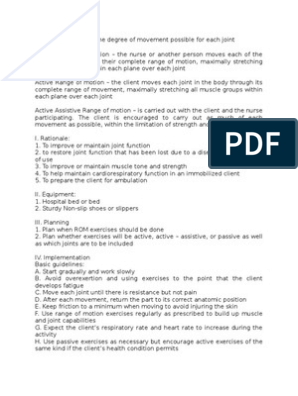Range of Motion, Body
Mechanics, Transfers &
Positioning
�Range of Motion
ROM is the extent
of movement that
a joint is normally
capable of.
�Hip ROM
Hip ROM includes
flexion, extension
and lateral &
external rotation
Adduction &
Abduction
�Hip ROM 1
�Hip ROM 2
�Hip ROM 4
�Hip ROM 4
�Yes, Elephants Dance
�Hand Movements (ROM)
ROM in wrist includes
flexion, extension,
radial & ulner
deviation
ROM in hands
include abduction,
adduction, flexion,
extension, opposition
and circumduction of
the thumb.
�Rotation
�Pronation and Supination
Quick Quiz: Which
is pronation?
�Extension
�Flexion
�Assessing Joint Mobility
Size, shape, color
& symmetry of
opposite joints.
Note masses,
deformities or
muscle atrophy.
�Assessing Joint Mobility
The ROM is
appropriate to each
joint and equal to
its opposite joint.
�Limitations
�Limited ROM in Neck of
Sable
�Walking Sables
�Aardvark Neck Limitation
Note Adaptation to ADLs (such
as they are.)
�ROM of Motion changes with
age
�Swelling, tenderness & pain
are among factors that limit
ROM.
�Body Movement
Movement, as in
the case of these
dancers, involves
voluntary and
involuntary
movement.
�Body Movement
Disruption of
voluntary/involunta
ry movement may
result in tremors
and seizures.
�Asymmetrical Movement
This type of
movement may be a
CNS disorder but is
most often a CVA.
Examples include
drooping on one side
of the body and a
foot-dragging gait.
� ROM and
ADLs
�Counter indication of ROM
1. Dislocated or unhealed fracture (fx).
2. Immediately after surgery (sx) on
tendons, ligaments, muscles, joint
capsules or skin.
�Precautions with ROM
1. Infection or inflammation around a
2.
3.
4.
joint.
Pain medication
Osteoporosis
Arthritis
�Age and sex affect ROM
�The effect of ROM on ADLs
Movement in bed
i.e. sitting in bed,
rising from bed and
turning over.
�Transfers:
Seat-to-Seat, Toilet to Bed, etc.
�Locomotion:
walking on level ground or
gentle slope
�Dressing
What affects would
not being able to
dress yourself have
on you? On your
client?
�Personal Hygiene
�Eating
�Body Alignment
�Keep Your Back Straight
�Correct Lifting
�The Correct Way to Lift
�When turning, rotate your
whole body, not just your back.
�When sitting keep your back
straight.
�Balance: Keep Your Feet 12
apart
�Coordinated Body
Movement
�Factors That Affect Body
Alignment and Mobility
1. Developmental---Age of Client
2. Physical HealthChornic or Acute
3.
4.
5.
Disease
Musculoskeletal: Congenital or
acquired abnormalities
Nervous System: CVA
Cardiovascular: orthostatic
hypotension, increased cardiac
workload, thrombosis
�Factors Affecting (cont)
6. Pulmonary: Atelectasis, Pneumonia
7. Metabolic: Immobility Affects Normal
Metabolic Functioning
8. Integumentary: Impaired Skin Integrity
9. Urinary: Urinary stasis, renal calculi, UTI
10.Mental Health: Physical Processes Slow
With Depression
All of These Effect.
�LIFESTYLE
�Normal Body Alignment
While Standing
While Sitting
While Lying In Bed
�Clients in Bed
Evaluate Comfort After Positioning for
Alignment
Reposition q2h Use Repositioning for
effective ROM
Use Supportive Devises for
Positioning
�Positioning
Clients
�Fowlers Positions
Close to High
Fowlers
Semi-Fowlers
�Supine position
�Side-lying/Dorsal Recumbent
Position
Major weight on
dependant hip and
shoulder.
Use supportive
foam blocks or
pillows for support
�Sims Position
Weight supported by
anterior aspects of
humerus, clavicle
and ileum.
These pressure
points are different
from other positions,
i.e. supine, thereby
preserving skin
integrity.
�Prone Position
This prone position
can be used to
prevent
contractures in
knees and hips.
Prone position
counter indicated
with spinal cord
clients.
�Prone Position 2
Airway, airway,
airway!!!
Pressure points
Ladies breasts
Mens genitailia
�Prone Position 3
Use support to
protect pressure
points, toes and
feet as done in this
picture.
�Sunset on the Zambeze.
����������Positioning/Moving a Client Up
in Bed
Allow patient to move himself if he can.
HOB down---dont move up hill.
Position height of bed for nurses comfort.
Have patient flex knees, chin to chest,
arms folded across chest
Nurses tightens abdominal girdles, flex
knees.
Nurses shift weight, moving patient.
Reposition HOB, bed in low position.
�Use Mechanical Devises
Lifts will save
backs, yours
included.
�Turning a Patient
Determine what patient can do, find
assistance if it is needed.
Position height of bed for nurses comfort.
Position patient supine on far side of bed.
Patient arms across chest, far leg over
near one.
Tighten girdles, flex knees.
�Turning Patient (cont)
Place one hand on patient shoulder,
other on hip.
Roll patient toward you.
Position patient for comfort, support
with pillows if need be.
Raise side rails, lower bed.
�ROM Goals
A goal of ROM is to
keep patient in the
best physical
shape possible.
Another goal is to
increase joint
mobility and to
increase circulation
to the affected
part.
�Passive ROM
The patient is
unable to move
independently and
someone else
manipulates body
parts.
�Active-Assistive ROM
The nurse provides minimal support
as the patient moves through ROM.
�Active ROM
The patient moves
independently through
a full ROM for each
joint.
�Only active ROM increases
muscle tone, mass, strength
and improves cardiac and
pulmonary functioning.
�Care Plan
ROM should be included in the patients
care plan unless counter indicated.
Move each joint to the point of
resistance, NOT pain.
Use good body mechanics as you do
ROM with your patients.
�From The Book of
Prue
Four nursing students try to carry
Prues book.
�Inspiration:
Where is nursing going
to take you?
--OR-Where are you going to
take nursing?
����Nursing Far Away
�Providing nursing care
for people whove never
seen a doctor
��from a never ending line.
�Doing Fun Things
�Seeing Wonders
�Seeing where the history
of other cultures was
made.
��Where do you plan to
take yourself while
nursing?







































































































